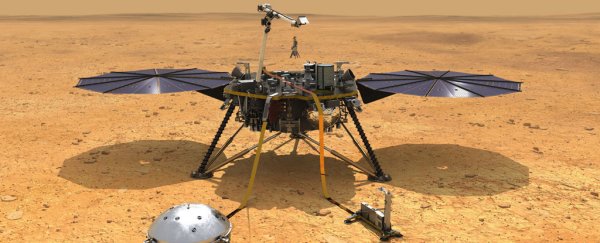The InSight Mars lander will cease science operations sometime in the next few months due to a decreasing power supply, mission managers said at a news conference on May 17.
Martian dust covering the solar panels has reduced the amount of power to roughly 500 watt-hours per Mars day or sol. When InSight landed in November of 2018, the solar panels produced around 5,000 watt-hours each sol.
"At the end of the calendar year, we do anticipate having to conclude all InSight operations," said Kathya Zamora Garcia, InSight's deputy project manager said at the briefing, "not because we want to turn it off but unfortunately we don't have the energy to run it."
But by mission end, InSight's tenure will have lasted almost twice as long as originally anticipated (four Earth years instead of the planned two years) and in its lifetime detected more than 1,300 marsquakes.
Recently, the lander detected its largest marsquake yet and the biggest quake ever detected on another world: a magnitude 5 event. The mission collected unprecedented data on Mars structure and interior.
"One of InSight's legacies is that it really proves the technique of seismology for planetary science," said Bruce Banerdt, InSight Principal Investigator, during the press conference. "We've been able to map out the inside of Mars for the first time in history."
"InSight has transformed our understanding of the interiors of rocky planets and set the stage for future missions," said Lori Glaze, director of NASA's Planetary Science Division. "We can apply what we've learned about Mars's inner structure to Earth, the Moon, Venus, and even rocky planets in other solar systems."
InSight's solar panels have been increasingly covered in Martian dust. The team has long been hoping a dust devil might clear dust off the panels, as happened for the Spirit and Opportunity Mars rovers. Alas, no such luck. But the creative engineering team took matters into their own hands, or robotic arm.
Since Mars dust is charged with static electricity, they took advantage of its magnetic properties on windy days to try and clean off the panels. InSight was commanded to scoop up Martian soil and drop it on the edge of the solar panels, causing the dust already on the panels to be attracted to the new dust.
This clever trick boosted InSight's energy production by about 5 percent each time, and the maneuver was done successfully six times, said Garcia.
The dust accumulation will likely only worsen as Mars now enters winter, when more dust is aloft in the atmosphere and less sunlight will be available.
 (NASA)
(NASA)
Because of the reduced power, the team will soon put the lander's robotic arm in its resting position (called the "retirement pose") for the last time later this month (see image above).
The team said that if just 25 percent of InSight's panels were swept clean by the wind, the lander would gain about 1,000 watt-hours per sol – enough to continue collecting science. However, at the current rate power is declining, InSight's non-seismic instruments will rarely be turned on after the end of May.
Now, they are prioritizing power for the lander's seismometer, which will operate at select times of day, such as at night, when winds are low and marsquakes are easier for the seismometer to "hear." They expect the seismometer will need to be turned off by the end of summer, which will conclude the science phase of the mission.
By then, InSight might have enough power to take an occasional picture and communicate with Earth. But the team expects that around December, power will be low enough that one day InSight will simply stop responding.
This article was originally published by Universe Today. Read the original article.
